Water RailSpotted CrakeBaillon's CrakeLittle CrakeEurasian MoorhenPurple Swamp-henCommon CootRed-knobbed Coot
Water Rail🠉
Rallus aquaticus
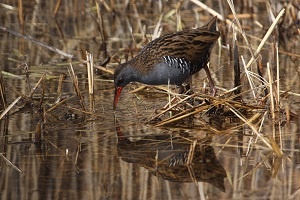
Fairly small rail with a long neck and a long, slightly curved bill. Appears quite dark from a distance with sharply contrasting pale undertail coverts.
Adult: Brownish above with black spots. Face and chest blue-grey. Flanks and belly with black and white barring. Bill dark brown and red. Legs reddish.
Juvenile: head paler and throat dirty white. Broad creamy supercilium and dark loral line. Throat dirty white. Chest and flanks brownish barred with dark and pale.
Voice: most well-known call, a pig-like squealing “gruii-gruii-gruii-gruiii”, descending the scale. Also a muffled “oouuuh” or a short “kipp”. Also sings at night: long series of “kupp-kupp-kupp” calls or “pupp-pupp-pupp-errrr.”
L. 23-26 cm ; W. 38-45 cm.
Similar species: Eurasian Moorhen, Spotted Crake, Little Crake, Baillon's Crake.
©Thomas Galewski
Spotted Crake🠉
Porzana porzana
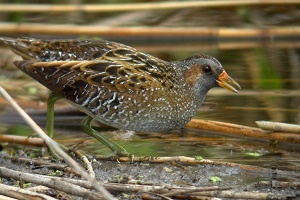
A little smaller than the Water Rail from which it can be distinguished especially by the short bill, usually uniform buff undertail coverts, green legs, and white leading edge of the wing in flight. Finely spotted with white on the neck, chest, and upperparts. Flanks barred. Bill greyish-yellow with a red base.
The adult has a bluish-grey supercilium, throat, lower neck, and chest. In the juvenile, these areas are whitish with the throat often white.
Voice: distinctive nocturnal song a soft, far-carrying “huit-huit-huit”, recalling regularly dripping water.
L. 19-24 cm ; W. 37-42 cm.
Similar species: Eurasian Moorhen, Water Rail, Little Crake, Baillon's Crake.
©Marc Thibault
Baillon's Crake🠉
Porzana pusilla
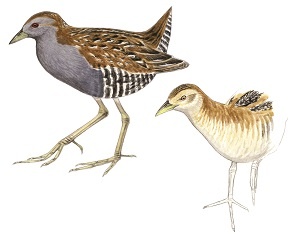
Small, and similar to the Little Crake. Differs from it by the shorter primary projection, relatively short tail, lack of red at the base of the bill, upperparts with white spots or rings, and clearer blackish and white barring below, on the rear body. The sexes are similar, but the female sometimes has a paler throat. The juvenile is dirty brown below and has more barring on the chest than in the Little Crake.
Voice: song recalling the call of an Edible Frog: a rolling “rrrrrr”, 2 to 3 seconds long, and varying in volume.
L. 16-18 cm ; W. 33-37 cm.
Similar species: Little Crake, Spotted Crake, Water Rail.
Little Crake🠉
Porzana parva
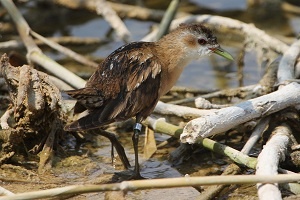
Small crake (size slightly less than the Spotted Crake); has a longer primary projection compared with the Baillon's Crake and a long pointed tail, a red base of the bill in adults, a few white streaks, and spots above and little or no barring on the rear body. The male is blue-grey below, while the female is buffish with a blue-grey tint on the head. The juvenile is similar to the female, but with whitish underparts and barred flanks. It only has a trace of red at the base of the bill.
Voice: piercing nocturnal call, “ouek-ouek-ouek”, repeated slowly at first, and then accelerating. The female gives a brief, nasal “koua-koua-kvarr”.
L. 16-18 cm ; W. 34-39 cm.
Similar species: Baillon's Crake, Spotted Crake, Water Rail.
©Thomas Galewski
Eurasian Moorhen🠉
Gallinula chloropus
Medium-sized. Dark, with the undertail white with a central dark stripe. Bill red with a yellow tip. Long green legs. Upperparts with brown tones, and underside dark slate-grey with a white line along the flanks. Flicks the tail when walking. Jerks the head when swimming.
Juvenile: grey-brown with whitish throat. Bill brownish.
Voice: piercing “krrruuu” or sharp “kik-kik”.
L. 27-31 cm ; W. 50-55 cm.
Similar species: Water Rail, Spotted Crake, Little Crake, Baillon's Crake.
©Thomas Galewski
Purple Swamp-hen🠉
Porphyrio porphyrio
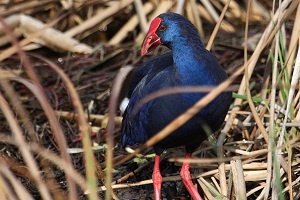
Large. Plumage dark blue with purple gloss, a large red bill, and a red frontal shield and long red legs. The white undertail coverts contrast sharply with the rest of the plumage. The subspecies caspius from the Caspian Sea and Turkey has a paler head, and the subspecies madagascariensis from Egypt has the upperparts tinged green.
Juvenile: duller and greyer overall with the underparts more grey-white, and the legs with a fleshy tone.
Voice: rich and varied, loud “kouek” calls or a drawn-out “kouaaaik”, among others.
L. 45-50 cm ; W. 90-100 cm.
Similar species : any in the area.
©Thomas Galewski
Common Coot🠉
Fulica atra
Large and plump with a broad body and a short tail. Head black and body sooty-grey, with white bill and frontal shield. In flight, narrow white trailing edge to the secondaries. Long green legs with lobed feet. Differences from Red-knobbed Coot: bill with a pink tinge (visible at long range), black markings coming to a point in front of the eye, white in the wing, etc.
Juvenile: paler, with grey-white on the throat and sides of the head.
Voice: rich repertoire, often heard at night. The loudest call is a piercing “keuk”.
L. 36-42 cm ; W. 70-80 cm.
Similar species : Red-knobbed Coot.
©Thomas Galewski
Red-knobbed Coot🠉
Fulica cristata
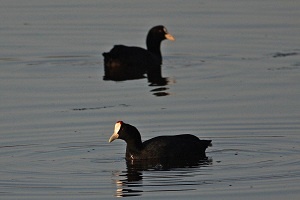
Similar to the Common Coot. Distinguished in the breeding season by the small dark red bumps on top of the frontal shield, which disappear quickly after breeding. When swimming, the stern is raised more than in Common Coot. Other distinguishing features: feathering between the eye and the bill is rounded, bill has a bluish tone, no white trailing edge to the wing, frontal shield “cut off” straight at the top (rounded in the related species).
Voice: sharp, nasal calls or hollow trumpeting cries, very different from the calls of Common Coot.
L. 39-44 cm ; W. 75-85 cm.
Similar species : Common Coot.
©Thomas Galewski






